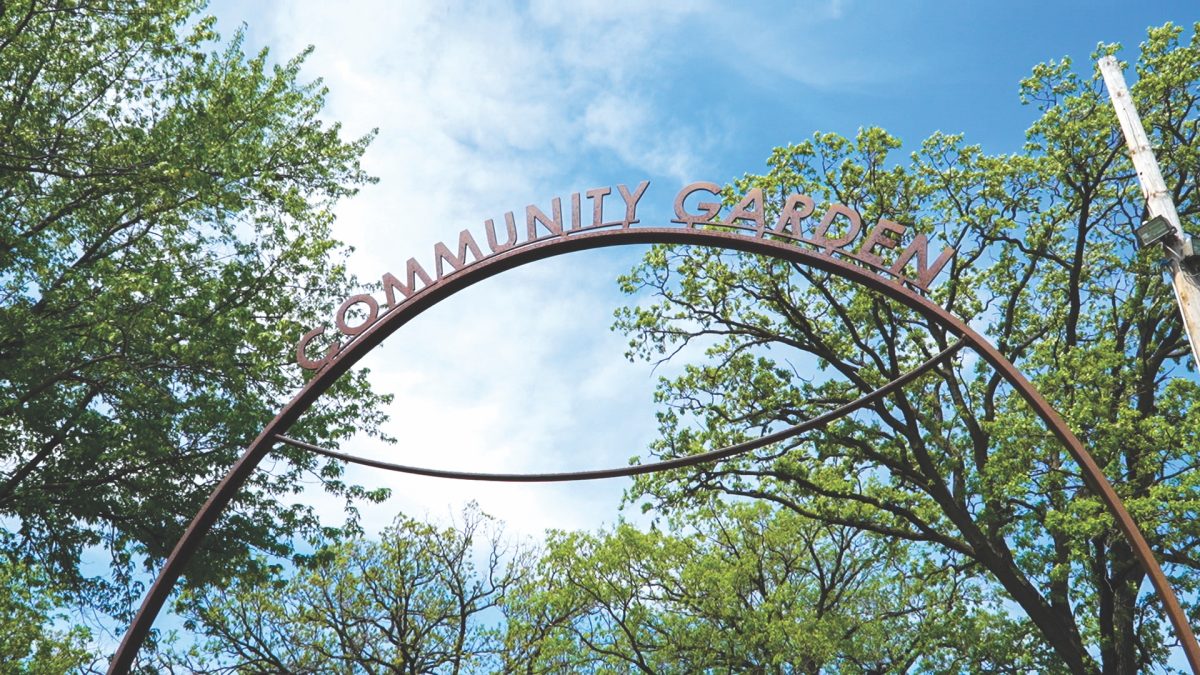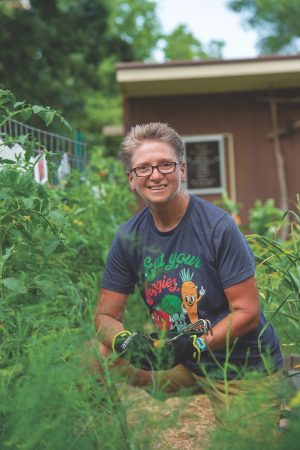
A beautiful diversity of living things have been sown and harvested in the St. Cloud State University Community Garden – all because 17 years ago Tracy Ore planted her vision and her knees on a scrubby patch of campus land on Fifth Avenue.
Tracy Ore and the multigenerational team of volunteer gardeners and community partners she has attracted to the garden have grown a rich array of produce, flowers and relationships on what soon became a campus/community intersection for cultivating what Ore calls “environmental and community sustainability.”
It’s a true community garden, an idea Ore says germinated as a result of one of those conversations that happen when a wonderful mentor comes along to change the trajectory of your life.
“I had taken my class to Detroit to be exposed to what activists were doing to rebuild that community,” said Ore, who in 2004 already had been a professor of sociology at SCSU for a few years, teaching classes on the politics of food and encouraging students to explore how food affects life in a variety of ways. There, in that industrial city particularly hard hit by the economically dismal early years of the 21st century, she met Grace Lee Boggs, a renowned Chinese-American human rights activist.
Ore confided that her family and friends all lived somewhere else, and she had little to keep her feeling grounded in St. Cloud. Boggs advised Ore to examine why she felt like always moving on, saying, “You need to stay in one place long enough in order to know its problems with authority.”
Believing, Creating, Sharing
Ore took Boggs’ comments to heart. “I knew then I needed to do something to build community here,” Ore said. Her answer was to create a plan for the garden and get others on board.
Within a year she had the university’s go-ahead to start the SCSU Community Garden, an outgrowth of her “Politics of Food” sociology course. It was slow-growing at first on the land that had been vacant for many years and seemed devoid of life. “This will never work,” the naysayers told her. “But I believed it
would,” said Ore, who had learned well from her innovative, self-sufficient mother that she could make something from nothing.

That something she created is a space where people of all ages learn how things grow, share their ideas and build a sense of trust with each other, just for showing up. “It’s amazing what happens when you have faith in people,” said Ore, who recently married her partner of 14 years and garden volunteer, Ariann Kramer. “The care and generosity they will show you is astounding.”
And just as the garden gave Ore that sense of belonging she was seeking, it now is producing a myriad of fruits and vegetables that remind campus and community members from diverse cultures of foods of their homelands and traditional foods.
“I’m on a mission about okra this year,” Ore said of the vegetable that is said to have West African, Ethiopian, Southeast Asian and South Asian origins that are familiar to many of SCSU’s thousand-plus international students as well as many community residents. “We’ve got 21 varieties of okra along with the potatoes and carrots in the garden, and we have a ‘Don’t settle for being mediokra’ t-shirt.”
Ore also is proud of the collard greens that have been grown and perfected since the inception of a 365-day a year project that started with now Professor Emeritus Robert C. Johnson, who works with African American Males Youth Forum. Ore said forum members were going out into the garden to collect collard greens, then started growing more to make centerpieces for the MLK Breakfast that featured greens as well as packets of seeds for guests to take home and grow their own. Leftovers have been sold at the Farmer’s Markets hosted on campus by Atwood every Monday during autumn, another offshoot of the SCSU Community Garden. Garden produce is canned and sold, including 14 varieties of jam and jars of beets, salsa and, of course, the ever-popular kosher dill pickles. This fall Ore and her volunteers put up 420 jars of the pickles in two days, and they’re not likely to be available for long.
A Special Place to Grow
The gifts of the garden are generously offered to campus and community. “Over the years the garden has become a very special place,” Ore said. “Children learn how things grow, and volunteers have a sense of trust with each other.”
Andrea Lawrence, who currently serves as mayor of Clearwater and manages another intersection of campus and community, the SCSU Welcome Center, was one of the first volunteers to discover how meaningful this new experience could be to her and her family.
Lawrence was attracted to join the small charter group of volunteers by the promise of taking home free organic produce and making new friends. She soon learned that the reputation the new garden had for having questionable growing soil had some merit. Of her early attempts to dig up the hard dirt with the other hardy garden pioneers, she recalls: “I remember trying to put the shovel in the ground,” she said. “It was like it rattled your teeth!”
“Those first couple of years I’d be on my hands and knees picking up the most random trash: a broken pair of handcuffs, bottles and cans – even a pair of high heels.”
Lawrence, who at the time was living on campus as residence hall director for SCSU’s Sherburne Hall, brought her three daughters to the garden from the time they were toddlers to play and learn. “Now they tell the funniest stories,” she said.
“One spring it was so muddy they were covered with it up to their waists,” she said. “Another time one of the girls jumped over the fence and got caught on her jeans, hanging by her pants loop.” As they grew, Lawrence brought her daughters’ pre-school classes, Girl Scout troops, and other groups of friends to show off the garden where they made lasting friends and learned the benefits of community gardening. “They loved it because they were garden royalty. They thought they were pretty cool.”
Another early volunteer was Matt Karpen, who works in construction and does “the oddball tasks,” for the garden, including building a whimsical spider trellis for vines to grow on, a foot-powered hand washing station during the pandemic, and a multipurpose gazebo on the north garden which doubled the original 500 square foot Community Garden space. A creative guy who tinkers with bikes and makes wild Halloween costumes, Karpen works in the garden for the love of making things and the love of pickles. His fee for building the gazebo was a case of his favorite pickles. “I like the bartering system,” he said. “We’re an actual community where everyone helps one another.”
Sometimes that help comes in the form of a place to go to be with friends during challenging times. For longtime volunteer Mary Jo Bot, the garden during the time of COVID was “a really bright spot.”
Bot, who is an SCSU graduate and emeriti member of the Music Department faculty, said “Tracy worked really hard to make the garden a safe place to be.”
Since it was outdoors people could still gather when everything else was so isolating, said Bot, who has expanded her friendships and her cooking repertoire through her time in the garden. “I like to cook so going to the garden gave me more interesting things to take home and make new things.”
Seven-year garden veteran Debra Japp, recently retired professor of Communication Studies at SCSU, said it took her awhile to respond to Ore’s email invitations to become a volunteer. “Now I’m hooked,” she said. “This is a tangible way of community interacting. It’s a cross-section group, and I’m enjoying it immensely.”
The garden is an amazing thing, Japp said. “There’s all kinds of ways for people to grow and fit it in. It’s a different side of creativity. Tracy truly has provided an amazing gift to the university and the community.”
A recent addition to the volunteer family, SCSU Computer Engineering Professor Ling Hou, said she had tried to have her own garden but realized that while she liked it, she wasn’t good at it. Now she’s learning by asking questions and asking what tasks need to be done. “I like to see how things grow,” she said. “It’s very therapeutic.”
While there are regular weekly times when greater numbers of volunteers are gathered, participants are not asked to have set times when they come and go. “It is free to be involved,” Ore said. “All we ask is that you contribute to the work, and you get to share in the harvest.” Volunteers appreciate the garden’s no-fences, no-set assignments, no-rules environment. “I try to let volunteers choose what they want to work on,” she said. “If you want to tend just one little flower, that’s okay.”
Karpen likes what he calls “Tracy’s vision for getting this back to the public – people who haven’t been exposed to it.” He said his parents always had a garden when he was growing up, and he likes the idea of getting people back into it, and “that whole general thing of being self-sufficient – people need that these days.”
When asked if she thought she’d achieved her goal for finding community for herself and others through the garden, she answers: “For sure I do. One of my favorite things now is that I’m no longer known as the sociology professor from New York. Now I’m the lady with the basil or that garden lady.”
